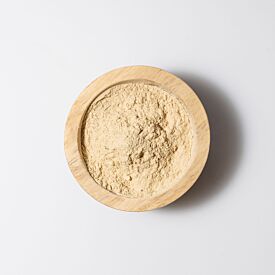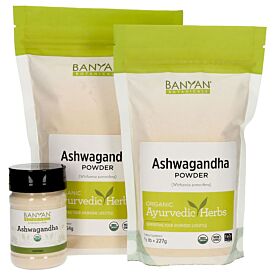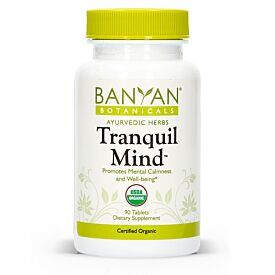The Benefits of Ashwagandha
Ashwagandha (Withania somnifera) has been used in Ayurveda for thousands of years as a rasayana (rejuvenative). It is a renowned adaptogenic herb, which means it is used to help the body resist physiological and psychological stress by adapting to the needs of the body. Deeply supportive of many tissues and body systems, including the immune system, the reproductive system, a healthy thyroid, and much more, ashwagandha is a wonderful herb to help nourish overall health and well-being.
In this article:
- Characteristics of the Ashwagandha Plant
- Ashwagandha Benefits
- Research on Ashwagandha
- Ashwagandha Uses
- Ashwagandha Recipes
- Growing Ashwagandha
What’s in a Name?
A fun fact about this beloved Ayurvedic herb is that the Sanskrit word “ashwagandha” translates as “the smell of a horse,” (ashwa—horse, gandha—smell), which refers to its ability to bring you the strength and stamina of a horse while nourishing the female and male reproductive and nervous systems.
Its botanical name, Withania somnifera, also tells us something about this herb: somnifera translates as “sleep-inducing,” reflecting its relaxing and calming properties that bring us energy by supporting deeper rest.
Ashwagandha has other names as well. It is often called “winter cherry,” referring to its small, red berry fruit that looks like a tiny cherry tomato.
Ashwagandha belongs to the Solanaceae, or nightshade, family—the same family as tomatoes and potatoes. Another common name is “Indian ginseng,” though it is not related to the ginseng family and most likely gets this name in reference to its energy promoting qualities.

Characteristics of the Ashwagandha Plant
Ashwagandha plants are native to India, northern Africa, and the Middle East, but they can now be cultivated in temperate climates around the world, including in the United States. We even grew some at our Southern Oregon project farm!
Interestingly, ashwagandha’s adaptogenic properties and its ability to help the body adapt to stress is reflected in the fact that the plant thrives in arid conditions and in poor quality, alkaline soils. While most plants would suffer from severe stress in this environment, ashwagandha flourishes.
This perennial shrub grows up to three feet tall, and the entire plant is covered in silver-gray, felted hairs. The leaves are oval and about two to six inches long, and its small, yellow-green, star-shaped flowers grow up to a half-inch in any direction. The ashwagandha berry is enclosed inside a papery calyx that serves as protection for the fruit.
Although the leaves and berries have therapeutic value, most of the benefits are derived from the stout, fleshy roots of the shrub, which is what we use at Banyan.
Ashwagandha Benefits
Ashwagandha is used to tone, support, strengthen, and revitalize bodily functions. It has been revered over time for its dual capacity to energize and calm at the same time.
Maximizing the body’s ability to resist stress, it enables the body to reserve and sustain vital energy throughout the day while promoting sound, restful sleep at night.
Stress can cause fatigue, often manifesting as “hyper” signs like agitation and difficulty sleeping. By providing a nourishing, yet energizing effect, ashwagandha can support a healthy nervous system.
With the use of ashwagandha, stress doesn’t impact the nervous system with such intensity, and the “hyper” signs of stress and agitation will naturally resolve over time. In this way, ashwagandha has a rejuvenating and calming influence on the nervous system and, consequentially, on the entire being.
This quality of ashwagandha makes it a prime supplement to use in the toning and rejuvenation process. In addition to its dual energizing and calming effect, ashwagandha offers a number of benefits:
- Supports a healthy immune system*
- Calms mental processes*
- Fosters healthy sleep patterns*
- Benefits a healthy reproductive system in both males and females*
- Supports sustained energy levels, strength, and vitality, including with physical activity*
- Supports a healthy back and joints*
- Supports healthy muscles*
- Promotes thyroid health*
- Promotes healthy functioning of the adrenals*
It's worth noting that this herb does have a warming quality. This may lead you to ask, "Is ashwagandha too heating for pitta dosha"? From the Ayurvedic perspective, ashwagandha is particularly balancing to vata and kapha. Because of its heating nature, it can aggravate pitta in excess.
We recommend using it with other herbs to balance out those heating qualities. A great way to do this is by taking an herbal formula like Stress Ease, which blends ashwagandha with cooling herbs like shatavari.
Research on Ashwagandha
Ashwagandha has become of interest to a number of researchers, particularly as it grows in popularity.
- It has been the subject of studies looking at the benefit on the immune system, including possible support of the immune system during radiation and chemotherapy.
- Used in combination with licorice (Glycyrrhiza glabra), shatavari (Asparagus racemosus), safed musli (Chlorophytum borivillanum), and sesame seeds (Sesamum indicum), ashwagandha has been shown to support healthy cholesterol levels and antioxidant properties.
- It has been studied for its stress-relieving effects, demonstrating its ability to help support individuals in times of stress and anxiousness.
- A study using male participants has shown ashwagandha’s ability to improve energy, strength, and vitality.
- Ashwagandha has been shown to support muscle mass, strength, and recovery.
- Additional studies on ashwagandha can be reviewed on PubMed.

Ashwagandha Uses
Ashwagandha is incredibly versatile—it can be taken as a powder, a tablet, or a liquid extract, with or without food, and at any time of the day, even right before bed. And while ashwagandha is a powerful herbal ally in its own right, you may wonder, "Can ashwagandha be taken with other herbs?"
The answer is absolutely! Ashwagandha pairs very well other herbs and is included in many of our herbal formulas. As an added benefit, ashwagandha root actually tastes good, and there are many delicious ashwagandha recipes, making it easy to incorporate this herb.
Take our free Ayurvedic Profile™ quiz to see if ashwagandha is one of the herbs recommended for you.
When incorporating this herb into your routine, you'll probably be wondering, "What is the recommended dose for ashwagandha, and for how long should I take it?
Our general recommended serving is 1/4–1/2 teaspoon of the powder, or 1–2 tablets, once or twice daily. As for how long it should be taken, that can depend on a few different factors, such as your constitution and state of balance, as well as your intention with the herb.
For some, it can take 3–6 weeks for the body to acclimate fully to a new herb or formula. You may decide to slowly stop using a formula once it's reached its desired effect, or continue taking it as a daily supplement. For many people, ashwagandha can be taken long-term, for months or years. Working with a practitioner is always the best way to determine the correct dose and period of use for you.
Traditionally used as a powder, ashwagandha can be mixed with water or warm milk and honey. Taken before bed, this mixture calms vata and fosters healthy sleep patterns, supports the reproductive system, and bolsters strength.
Ashwagandha is traditionally taken with ghee and honey (equal parts), which act as anupans (a medium for carrying herbs deeper into the tissues) for overall nourishment and rejuvenation.
While combining equal measurements such as 1/2 a teaspoon each is fine, be sure you are not putting in equal weights of honey and ghee (such as 1 gram each) as this is considered toxic.
Taking ashwagandha with raw sugar adds a cooling effect and can even be substituted for the honey, particularly in the summer months. It can also be used with ghee and sugar as a supplement to support the female reproductive system and joints.
The Ayurveda's Carrier Substances guide is a great resource for determining which anupan is most appropriate to use.
| Ashwagandha Tea Recipe |
Ingredients:
|
| Directions: Combine hot water with Ashwagandha powder and mix well. Add honey to taste. Sip and enjoy! |
| Ashwagandha Tonic Recipe |
Ingredients:
|
| Directions: Simmer 1 to 2 teaspoons powdered ashwagandha in 2 cups milk over low heat for 15 minutes. Add 1 tablespoon raw sugar and 1/8 teaspoon cardamom and stir until well mixed. Turn off heat. Drink a cup once or twice a day for a pick-me-up. |
Additional Ashwagandha Recipes
- Chocolate Tahini Ashwagandha Cups
- Energy Balancing Truffles
- Ashwagandha Almond Butter
- Grounding Trail Mix
- Comforting Cashew Night Tonic
- Ayurvedic Super Milk Recipes
- Ashwagandha Latte Recipes
If you prefer a more convenient way of taking your supplements, ashwagandha is also available in tablet form. This can be an easier method, especially for those that travel a lot, have a shortage of time, or do not like the taste of ashwagandha tea.
Banyan Botanicals prefers tablets over capsules as it is still possible to taste the herb. Taste starts the digestive process and sends signals to the body as to what to expect, initiating the body’s own inner pharmacy. Take 1–2 tablets once or twice daily, in the morning, at night, or whenever is most convenient for you. They do not need to be taken with food.
Ashwagandha liquid extract is also available and provides an alternative method of taking this herb. It’s convenient, easy to assimilate, and has a long shelf life. Add 30 ml (approximately one dropperful) to water or juice 1–3 times daily.
In addition to ashwagandha powder, liquid extract, and tablets, Banyan Botanicals also uses organic ashwagandha in several product formulas:
- Healthy Vata
- I Sleep Soundly
- Men’s Support
- Stress Ease
- Ashwagandha Bala Oil
- Ashwagandha Latte
- Elevated Adaptogens
Contraindications
- Large doses of ashwagandha can cause abdominal discomfort and diarrhea. Ashwagandha has otherwise been tolerated well in the few reported studies that exist.
- Though the herb is traditionally used in India during pregnancy, it is recommended that ashwagandha be avoided in pregnancy in the West; this is because of its spasmolytic activity on the uterus, and its induction of abortions in animals when given in very large doses.
- From an Ayurvedic perspective, use ashwagandha with caution in cases of excess pitta and ama.
From Seed to Harvest: Banyan’s Ashwagandha
Any time you purchase an herb, there are a variety of questions to consider relating to the quality of the herbs, the values of the company, and the impact on the environment. We are committed to providing the highest quality organic ashwagandha that is grown sustainably and is fairly traded.
On the Map: Where Banyan’s Ashwagandha Is Grown
All of Banyan’s ashwagandha is grown in an arid region of north Karnataka (Southwest India). Due to the harsh farming environment and the limited choice of crops that can be grown, farmers here are poorer than average, and few can afford to dig wells for irrigation.
Ashwagandha is remarkably drought-resistant, making it the perfect crop choice for areas that are difficult to irrigate.
Caring for the Ashwagandha Plant from Seed to Harvest
As with any farming story, our ashwagandha plants’ journey starts with the soil before the seeds are even sown. In order to provide certified organic ashwagandha, we must first start with certified organic land, and all farming practices must meet stringent organic regulations, ensuring no synthetic fertilizers, pesticides, or other harmful chemicals are used.
Tending to the seeds is next. The way in which herbs are grown on the farm can have a significant influence on the quality and cost of the final product. In the case of ashwagandha, the spacing of the seedlings in the field is a surprisingly important factor.
Seeds are sown at the beginning of the monsoon season and harvested approximately five months later. The distance between the plants, combined with the time of harvest, determines the thickness, shape, and fiber content of the root.
If the seedlings are planted too close together, or harvested too early, they will not be well developed, and result in a poor yield. If the seedlings are spaced too far apart, or left in the field for too long, a thicker fibrous root will develop, which causes challenges when attempting to produce a uniform fine powder.
This is just one example of why it’s so important for us to support projects that maintain close relationships with the farmers. Only with regular communication and feedback can our herb suppliers understand and respond to the challenges faced on the farm.
And as a result of this dedicated communication, we get correctly spaced out seedlings that produce perfectly powderable ashwagandha.

Sustainability and Fair Trade in Action
Verifying sustainable planting and harvesting of our ashwagandha is another key part of the story.
All herbal companies have a choice in how ashwagandha is gathered, and like most other herbs, they can be harvested on private farms where sustainability can be managed, or they may be wild-harvested legally from their natural habitats.
Sometimes the herbs, particularly the endangered ones, are taken illegally, threatening long-term sustainability.
Because we maintain a connection with the farmers, we can ensure sustainable planting and harvesting of our ashwagandha plants.
It goes without saying that this whole process wouldn’t be possible without the farmers. Without their care, we couldn’t provide such amazing, high-quality ashwagandha.
Banyan strongly believes in making sure the farmers are cared for as a part of the supply chain. In addition to preserving our own relationship with our farmers, the farms we source from are inspected to make sure they follow fair-trade principles.










